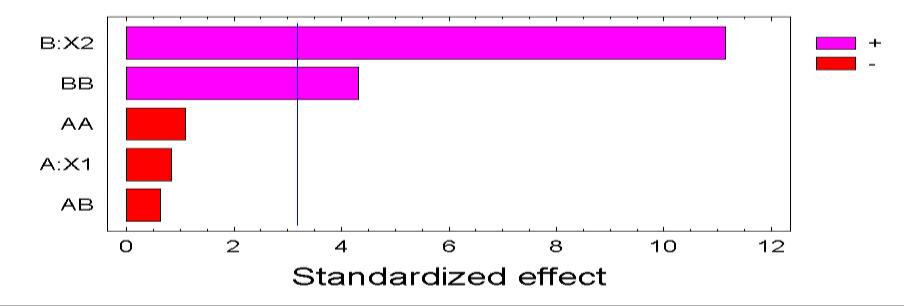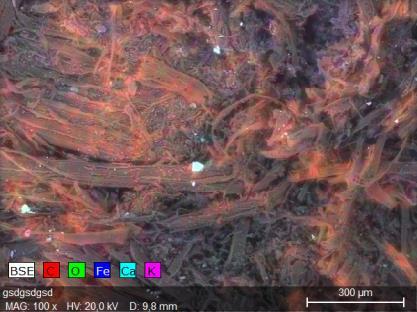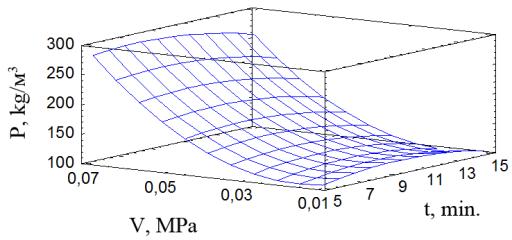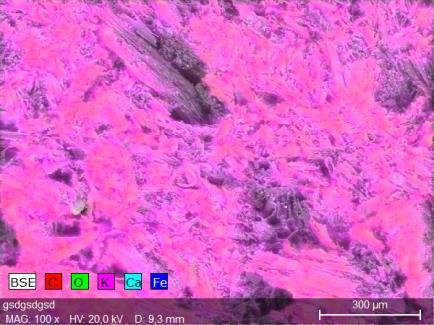
11 minute read
Tab. 4 Experimental matrix.
To estimate the effects of the control variables (AA and A: quadratic and linear effects of the vacuuming time on the absorption value; BB and B: similar effects for the underpressure; AB: combined effect of the two factors), we drew a Pareto diagram (Fig. 10) using a regression analysis in the STATGRAPHICS Centurion 18 software.
The results indicate that the underpressure has the greatest influence on the absorption value. There are just two significant factors: В and ВВ. Such a high significance of B can be explained as follows: the material contains a larger number of air-filled pores. The air is replaced by the flame retardant during impregnation. It is known that overpressure during the impregnation of such materials, including wood, reduces the air volume and increases its pressure. This slows or even stops the fluid transfer in the material (Shamaev et al., 2013). The vacuum removes some of the air and promotes the fluid transfer to fill the free volume of pores across the sample with the flame retardant, as the results show. The high significance of BB is probably because the material has pores of different pores with poor transport between the pores. It does not allow for air removal at an underpressure of less than 0.04 MPa to increase the absorption of the flame retardant.
Advertisement
Eq. (4) is the regression model (96.04 %, representativeness) which includes the effects shown in Fig. 10. The response surface in Fig. 11 shows that the nonlinearity is largely caused by the underpressure (mainly represented by the quadratic BB effect).
The relationship is non-linear. It can be seen that underpressure is the limiting factor. The max increase in absorption (more than twofold) was found as the underpressure was increased from 0.04 to 0.07 MPa for virtually the same hold period. The max flame retardant absorption of 288.4±3.1 kg/m3 is achieved at the underpressure up to 0.07 MPa.


Scanning electron microscopy (SEM) and energy dispersive X-ray spectroscopy (EDX) Test results of the control samples’ central part surface obtained with the aid of scanning electron microscopy (SEM) and EDX indicate a potassium (K) exposure near 1%, which is due to inferiority of the accepted sample preparation technique (Fig. 12a). In addition to it, the elemental composition of the considered part of the sample’s surface includes carbon (C) about 50% and oxygen (O) about 30 % (Table 5).
The autoclave impregnation process allowed the distribution of flame retardant 4 through the entire volume of the wood panels. A sample impregnated with flame retardant 4 (Fig.12b) contains 31.34% of potassium (Table 5). The presence of potassium in such a significant amount may indicate that the working substance in the flame retardant composition is potassium carbonate (K2CO3). Since the purpose of flame retardants is to prevent, delay ignition and reduce the consequences of fire, achieving deep penetration of the impregnating flame retardant will increase the level of fire protection of the material under study (Elvira-León et al., 2016).

Determination of flame retardant efficiency
The results of inflammability tests and appearance before and after testing are presented in the Table 6 and in the Figure 13 respectively.
During the test, there was no temperature increase in gaseous combustion products (∆tmax). The temperature of the gaseous combustion products (∆tmax) decreased from 201.7±1.5 0С to 60.9±9.2 0С for (300 ± 2) seconds. The obtained data are consistent with that presented in (Seo et al., 2017), where it is noted that wood samples undergone vacuum impregnation with an aqueous solution of flame retardants (diammonium phosphate and potassium carbonate) show less heat formation than samples after surface treatment.
As known, a smaller mass loss of the sample during the fire tests indicates a high resistance to thermal destruction under fire. As a result of using flame retardant, when exposed to fire, the mass loss of the sample averaged 29.0 ± 6.9 %.
Studies conducted on fiberboard (Özdemiretal, 2013) have shown that adding 9% of dry ammonium polyphosphate (APP) fiber to UF resin reduces weight loss by 37.3 % compared to the control sample. Ibragimov et al. (2020) achieved a 1.3...3.2-fold reduction in mass loss when burning heat insulating material samples of cotton, linen fibers, and wood chips by adding coke-forming flame retardants (sodium carbonate (Na2CO3) or aluminum trihydrate (Al2O3) in amounts of 30 % of plant filler) to the binder.
Such patterns of mass change can be explained by the fact that after putting the test sample into the chamber of the experimental installation, the flame retardant swelling began with gas release and foam coke formation. The carbonized layer helps to limit the spread of gaseous decomposition products of the sample, as well as oxygen access to its surface. An increase in the spread of carbonized products and the volume of the foam-coke layer reduces the number of gaseous products entering the combustion zone, reduces the rate of heat transfer to the layers located at the bottom of the coating. (Levan et al., 1990, Khalturinskiy et al., 2011,Chuang et al., 2010).
Fig.
The experiment proved flame retardants increases the fire resistance of binder-free wood boards making them low-combustible. Indeed, the temperature of the combustible gases released as the material is heated has decreased (∆tmax<60 0С), the mass loss rate does not exceed 60%. It means the material has a higher thermal resistance. In accordance with the GOST 12.1.044-89 standard, it matches the criteria for “hardly combustible materials”.
Conclusions
This study was aimed at estimating the binder-free wood board fire protection efficiency. The autoclave impregnation process allowed making them low-combustible material when tested as specified in the GOST 12.1.044-89 standard. Such boards are not commercially available now, but are of great research interest, as evidenced by similar studies. Boards made of activated wood particles have a wide range of absorption capacity (103.8±1.4-288.4±3.1 kg/m3). It enables their modification by deep impregnation with fire retardant and other liquid compositions. This approach is new and requires a comprehensive study since it expands the possibilities of obtaining binder-free materials with specified properties. Modified panels can be used in construction, e.g., for the manufacture of enclosing structures. To further improve the fire protection processes of binder-free lowdensity wood boards, it is necessary to study the effect of autoclave impregnation on their physical and mechanical properties.
References
Abu-Jdayil, B., Mourad, A.H., Hittini, W., Hassan, M.,Hameedi, S., 2019. Traditional, state-of-theart and renewable thermal building insulation materials: An overview. Construction and Building Materials, 214, 709-735.
Andreeva,E.D.,PrintsevaM.YU.,CheshkoI.D., 2013. Application of infrared spectroscopy method for the flame-retarded wood. FireSafety, No. 4, 69-73.
Antonov,A.V.,Petrusheva,N.A.,Alashkevich,Yu.D.,2012. Obtaining fire-proof fiberboards. News of Higher Educational Institutions. Forest Magazine, No. 4 (328), pp. 99-103.
Antsupov, E. V., Rodivilov S. M., 2011. Flame retardants for porous materials // Fire and explosion safety. - Т. 20. - №. 10. - С. 25-32.
Aseeva R. M., Serkov B. B., Sivenkov A. B., 2007. Efficiency and action mechanism of two flameretardant systems for wood Fire and explosion safety, V. 16, № 5, 23-30.
Azarov, V.I., Burov, A.V., Obolenskaya, A.V., 2010. Chemistry of Wood and Synthetic Polymers: Textbook, 2nd ed.; Lan, Saint-Petersburg, Russia, p. 624. Lan: electronic library system. Available online: https://e.lanbook.com/book/4022 (accessed on: 12.10.2022).
Bahrani, B., Hemmati, V., Zhou, A., Quarles, S. L., 2018. Effects of natural weathering on the fire properties of intumescent fire‐retardant coatings. Fire and Materials, 42 (4), 413-423.
Bayandin,M.A.;Ermolin,V.A.;Ostryakova,V.A.,Namyatov,A.V., 2021. Study of the properties of mechanically activated wood pulp for the production of adhesive-free wood boards. Actual problems and prospects for the development of the timber industry: Materials of the IV International Scientific and Practical Conference, Kostroma city, Russia, 08-11 September, 2021. Editors: Titunin, A.A., Vakhnina, T.N., Kostroma: Kostroma State University, pp. 10-13.
Bazhenov,V.A.,MoskalevaV.E.,1953. On the permeability of sapwood and pine kernels byliquids and the possibility of its regulation // Tr. Institute of forests of the USSR Academy of Sciences. Vol. 9. P. 205–216.
Bezzaponnaya,O.V.,Golovina,E.V.,MansurovT.K.,AkulovA.Y.,2017. Application of the thermal analysis method for a comprehensive study and improvement of intumescent flame retardants.
Tekhnosfernaya bezopasnost', V 2, No. 15, pp. 3-7.
Brosse,N.,EL Hage,R.,Chaouch,M.,Petrissans,M.,Dumarcay,S.,Gérardin,P., 2010. Investigation of the chemical modifications of beech wood lignin during heat treatment. Polymer Degradation and Stability 95(9): 1721-1726.
Bunzel,F.,Ritter,N.,2017.WoodFoam.InCultivatedBuildingMaterials(pp.100-107).Birkhäuser.
Bunzel, F., Kowalik, T., Scholz, S., Hohlfeld, J., 2018. Wood Foam and Metal Sponge Hybrid Material. Lightweight Design worldwide, 11(6), 32-37.
Cheshko I.D., Printseva M.Yu.; Mokryak A.Yu Pariyskaya A.Yu 2016. Possible applications of scanning electron microscopy and X-ray microanalysis in solving forensic fire examination Saint-Petersburg university of State fire service of EMERCOM of Russia, 84-92.
Chuang, C.S., Tsai, K.C., Wang, Y.C. et al., 2010. Impact of wetting and drying cycle treatment of intumescentcoatingsonthefireperformanceofthinpaintedredlauan(Parashoreasp.)plywood. J Wood Sci 56, 208-215.
https://doi.org/10.1007/s10086-009-1089-2 https://doi.org/10.1007/BF00353254
Chudinov, B.S. Water in wood [Text]: monograph / B.S. Chudinov; ed. A. Bazhenov ; Academy of Sciences of USSR, Siberian Branch, Institute of Forest and Wood named after Suchechev. V. N. Sukachev. - Novosibirsk: Nauka. Siberian Branch, 1984. - 272 с. Bibliography: pp. 263-269.
De Luca, P., Carbone, I., Nagy, J. B., 2017. Green building materials: A review of state of the art studies of innovative materials. Journal of Green Building, 12 (4), 141-161.
Donaldson, L.A., Lomax, T.D.1989. Adhesive. Fibre Interaction in Medium Density Fiberboard. Wood Science and Technology, vol. 23, iss. 4, pp. 371–380.
Dubrulle,L.,Zammarano,M.,Davis,R.D.,2020.Effect ofFire-Retardant CoatingsandAcceleratedWeathering on the Flammability of Wood-Based Materials in Wildland-Urban Interface (WUI) Communities. NIST Tech. Note, 2094, 1-30.
Elvira-León, J. C., Chimenos, J. M., Isábal, C., Monton, J., Formosa, J., Haurie, L., 2016. Epsomite as flame retardant treatment for wood: Preliminary study. Construction and Building Materials, 126, 936-942.
Ermolin, V. N., 1999. Fundamentals of increasing the permeability of coniferous wood liquids: Monograph; Siberian State Technical University. Krasnoyarsk.
Ermolin, V.N., Bayandin, M.A., Kazitsin, S.N., 2020. Water resistance of wood slabs obtained without the use of binders. News of Higher Educational Institutions. Forest Magazine, No. 3 (375), pp. 151-158. https://doi.org/10.37482/0536-1036-2020-3-151-158
Ermolin, V.N., Bayandin, M.A., Kazitsin, S.N., Namyatov, A.V., 2019. Structure formation of lowdensity boards from hydrodynamically activated soft wood waste. News of Higher Educational Institutions. Forest Magazine, № 5 (371), pp. 148-157. https://doi.org/10.17238/issn05361036.2019.5.148 https://doi.org/10.15376/biores.13.1.Hubbe https://doi.org/ 10.15393/j2.art.2019.4722
Ermolin, V.N., Kazitsin, S.N., Bayandin, A.V., Namyatov, A.V., 2017. Developing the mode for hydro dynamic activation of wood particles for adhesive-free panels production. Conifers of the Boreal Zone, V. 35, No. 3-4, pp. 79-83.
Ermolin, V.N.; Ermolina, A.V., 2015. Increasing the fire resistance of heat-insulating wood slabs. Conifers of the Boreal Zone, V. 33, No.1-2, pp. 82-86.
Golubev, E., Dyageleva, A., Smirnova, A., 2020. Methods of modification of wood with the use of chemical means of protection. Norwegian Journal of Development of the International Science, No. 43-1, pp. 3-6.
GOST 12.1.044 - 89 OSSS. Fire and explosion hazard of substances and materials. Nomenclature of indicators and methods of their determination (IS0 4589-84).
GOST 17177-94. Materials and products of thermal insulation construction. Test methods. Interstate Scientific and Technical Commission for Standardization, 1994.
GOST 20022.6-93 Interstate standard. Wood protection. Methods of impregnation. Introduction 1995-01-01. Minsk: Gosstandart of Russia, 1993.
GOST R 53292–2009 Flame retardants and substances for wood and materials based on it. General requirements. Test methods. Moscow City, Publishing House of Standards, 2009, p. 18.
Hagen, M., Hereid, J., Delichatsios, M. A., Zhang, J., Bakirtzis, D., 2009. Flammability assessment of fire-retarded Nordic Spruce wood using thermogravimetric analyses and cone calorimetry. Fire Safety Journal, 44 (8), 1053-1066.
Hubbe, M.A.; Pizzi, A.; Zhang, H.; Halis, R., 2018. Critical Links Governing Performance of SelfBinding and Natural Binders for Hot-Pressed Reconstituted Lignocellulosic Board without Added Formaldehyde. A Review. BioResources, vol. 13, no. 1, pp. 2049–2115.
Ibragimov,A.M.,Vachnina,T.N.,Susoeva,I.V., 2020. Use of Mineral Flame Retardants to Reduce the Combustibility of Thermal Insulating Board Composites from Plant Waste. In IOP Conference Series: Earth and Environmental Science (Vol. 459, No. 6, p. 062115). IOP Publishing.
Khalturinskiy, N.A., Krupkin, V.G., 2011. On mechanism of fire retardant intumescent coating formation. Fire and Explosion Safety, 20(10), 33-36.
Kolesnikov, G.N., Kantishev, A.V., Zaitseva, M.I. et al., 2019. Analysis of wood impregnation as a capillary-porous material. Resources and Technology, V. 16, No. 2, pp. 141-151.
Krivonogov, A. S., et al., 2018. Theoretical substantiation of the process of fluid movement in capillary-porous media in the context of increasing the strength characteristics of the material. Systems. Methods. Technologies, No. 3, pp. 130-135. https://doi.org/10.18324/2077-54152018-3-130-135
Kulakov, V.S, Krasheninnikova, N.N, Sivenkov, A.B., 2021. Reduction of fire hazard of wooden building structures by the method of deep impregnation of wood with a fire and biological protection composition KSD-a (mark 1). Fire and Explosion Safety, V. 21, No. 3, pp. 31-38.
Leonovich, A.A. 2003. Physico-chemical bases of the formation of wood slabs. Chemizdat, SaintPetersburg, Russia, p. 192.
Levan, S.L.; Winandy, J.E., 1990. Effect of fire-retardant treatments on wood strength: A review. Wood and Fiber Science 22 (1): 113-131.
List of certified fire safety equipment. Fire and Explosion Safety 1998, No. 1, pp. 104-118.
Maksimenko, S.A., Krivtsov, N.A., Maksimenko, N.A. et al. 2013. Fire hazard of new types of timber. Fire Safety, No. 2, pp. 74-77.
Monteiro, S., Martins, J., Magalhães, F. D., Carvalho, L., 2019. Low density wood particleboards bonded with starch foam study of production process conditions. Materials, 12 (12), 1975.
Namyatov,M.A.,Bayandin,S.N.,Kazitsin,S.N.,Ermolin,V.N.,2018. Investigation of the properties of boards, small density from mechano-activated wood chips without adhesives. Structure, properties and quality of wood: Materials of the VI International Symposium named after B.N. Ugolev, dedicated to the 50th anniversary of the Regional Coordinating Council on Modern Problems of Wood Science, Krasnoyarsk city, Russia, 10-16 September, 2018. Krasnoyarsk city, Publishing House of the Siberian Branch of the Russian Academy of Sciences, pp. 149151.
Özdemir,F.,Tutuş,A.,2013.EffectsofFireRetardantsontheCombustionBehaviorofHigh-Density Fiberboard. BioResources, 8(2).
Panev,N.M.,2018. Analysis of the use of flame retardant compositions for wood and development of methods for monitoring their availability. Dissertation for the degree of Technical Sciences Candidate, p. 148.
Pham Van, T., Schöpper, C., Klüppel, A., Mai, C., 2021. Effect of wood and panel density on the properties of lightweight strand boards. Wood Material Science & Engineering, 16(4), 237-245.
Printseva M.Yu., Cheshko I.D., 2014. Thermal analysis and infrared spectroscopy of gaseous products of thermal destruction in the expert research of flame-retarded wood. Fire Safety, № 3, 96-101.
Prokopenko,V.A., 2019.The effect of the depth of impregnation on the fire resistance of low-density wood slabs without binders. Young scientists in solving urgent problems of science: A collection of materials of the All-Russian Scientific and Practical Conference of students, postgraduates and young scientists, Krasnoyarsk city, Russia, 25-26 April, 2019, Krasnoyarsk: Federal State Budgetary Educational Institution of Higher Education Siberian State University of Science and Technology named after Academician M.F. Reshetnev, pp. 245-247.
Sable, I., Grinfelds, U., Vikele, L., Rozenberga, L., Zeps, M., LUGUZA, S., 2015. Thermal insulation from hardwood residues. In IOP Conference Series: Materials Science and Engineering (Vol. 96, No. 1, p. 012027). IOP Publishing.
Selamat, M. E., Hui, T. Y., Hashim, R., Sulaiman, O., Haafiz, M., Kassim, M., STALIN, N. J., 2018. Properties of Particleboard Made from Oil Palm Trunks Added Magnesium Oxide as Fire Retardant. Journal of Physical Science, 29 (1).
Seo, H. J., Hwang, W., & Lee, M. C., 2017. Combustion Characteristics of Fire Retardants Treated Domestic Wood. Journal of the Korean Society of Combustion, 22(2), 9-18.
Shamaev, V.A., Nikulina N.S., Medvedev I.N., 2013. Wood Modification: Monograph. Moscow, FLINTA Publ., 448 p.
Sheloumov, A.V., 2017. (Saint-Petersburg). Technology of environmentally sound fire-proof wood boards using phosphorus- and aluminum-containing binders. Specialty 05.21.05 Wood science, technology and equipment of wood processing: abstract of the dissertation for the degree of Doctor of Technical Sciences, p. 22.
Shvartsman, G.M. 1997. Production of chipboard [Text]: Tutorial / G.M. Shvartsman, D.A. Shchedro. - M.: Forest Industry, 320 p.
Sinha, S., Jhalani, A., Ravi, M.R., Ray, A., 2000. Modelling of pyrolysis in wood: a review. SESI Journal 10(1): 41-62.
Sivenkov, A.B., 2015. The influence of physico-chemical characteristics of wood on its fire hazard and fire protection efficiency. Specialty 02.00.06 High molecular compounds: abstract of the dissertation for the degree of Doctor of Technical Sciences, p. 22.
Taavitsainen, V.-M.T., 2011. Experimental Optimization and Response Surfaces; IntechOpen: London, UK.
Tang, W.K., 1967. Effect of Inorganic Salts on Pyrolysis of Wood Alpha Cellulose and Lignin Determined by Thermogravimetry, FPL 71, Madison Wisconsin; US Department of Agriculture, Madison, Wisconsin.
Uner, I. H., Deveci, I., Baysal, E., Turkoglu, T., Toker, H., Peker, H., 2016. Thermal analysis of Orientalbeechwoodtreatedwithsomeboratesasfireretardants.Maderas.Cienciaytecnología, 18(2), 293-304.
Wang,F.,Wang,Q.,Wang,X., 2010. Progress in research on fire retardant–treated wood and woodbased composites: A Chinese perspective. Forest Products Journal, 60 (7-8), 668-678.
Zhang, B., Yu, L., Zhang, Q., LI, D., Tu, Y., Xiao, G., Liang, J., 2022. Effects of fire retardants on mechanical properties and water resistance of pinusmassoniana particleboard. Wood research, 67(3), 411-422.
Funding
This research was carried out within the state assignment of the Ministry of Science and Higher Education of the Russian Federation for the implementation of the project “Development of multifunctional smart materials and structures based on modified polymer composite materials capable to function in extreme conditions” (project number FEFE-2020-0015).
Acknowledgments
This research was partially carried out using the equipment of Krasnoyarsk Regional Center of Research Equipment of Federal Research Center “Krasnoyarsk Science Center SB RAS”.
AUTHORSʼ ADDRESSES
Sergei Kazitsin
Aleksey Namyatov
Mikhail Bayandin
Nina Grotskaya
Reshetnev Siberian State University of Science and Technology
31 KrasnoyarskyRabochy Av
Krasnoyarsk 660037
Russian Federation sergeikaz060890@yandex.ru namyatov2010@yandex.ru mihailbayandin@yandex.ru grotskayanina@mail.ru







